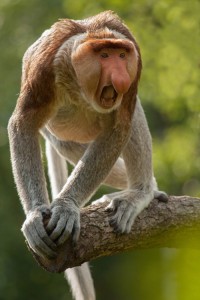Monster Monday: the Proboscis Monkey
December 19, 2016
This Monday’s monster—perhaps more comical than monstrous—gets its name from its rather prominent proboscis (nose). Its scientific name, Nasalis larvatus, means nose mask. In fact, the “schnoz” on the proboscis monkey is the longest and largest of all primates. Among adult males, the average snoot is up to 7 inches (18 centimeters) long. Some male proboscis monkey sniffers are so large that they must be pushed aside in order to eat!

The proboscis monkey gets its name from its prodigious nose. Credit : © Berendje Photography/Shutterstock
Proboscis monkeys don’t seem to resent “big-nose jokes” told by other primates (including humans, of course). Instead, they seem rather proud of their humongous honkers. Male proboscis monkeys use their giant noses to trumpet loud bellowing noises that warn of predators, shoo away rivals, or even attract mates.
Proboscis monkeys are large monkeys that live only in the swampy forests of Borneo, an island in Indonesia. They feed mainly on leaves, fruits, and flowers. These monkeys also tend to have large stomachs (necessary to digest their leafy diet), giving them an amusing potbellied appearance to go with their super snouts. Adult proboscis monkeys have reddish hair on their heads, backs, shoulders, and thighs, and pale gray hair on the arms and legs. People of Borneo call them bekantan. But some locals on the island jokingly refer to the monkey as an orang belanda (Dutch person) because of its supposed resemblance to overfed colonists of times past. (Indonesia was once part of the Dutch East Indies, a colony created by the Netherlands.)
Zoologists studying proboscis monkeys in the wild have found that females, which lack the distinctive large noses, find the male’s facial appendage rather attractive. Biologists understand that adults of many species prefer mates who display certain behaviors or have certain exaggerated external features. Over time, this process can lead to the evolution of complicated courtship rituals, bright coloring to attract mates, and other unusual physical features (see the sexual selection paragraph in the evolution article). From the female proboscis monkey’s point of view, it seems the bigger the nose, the more attractive the male.


